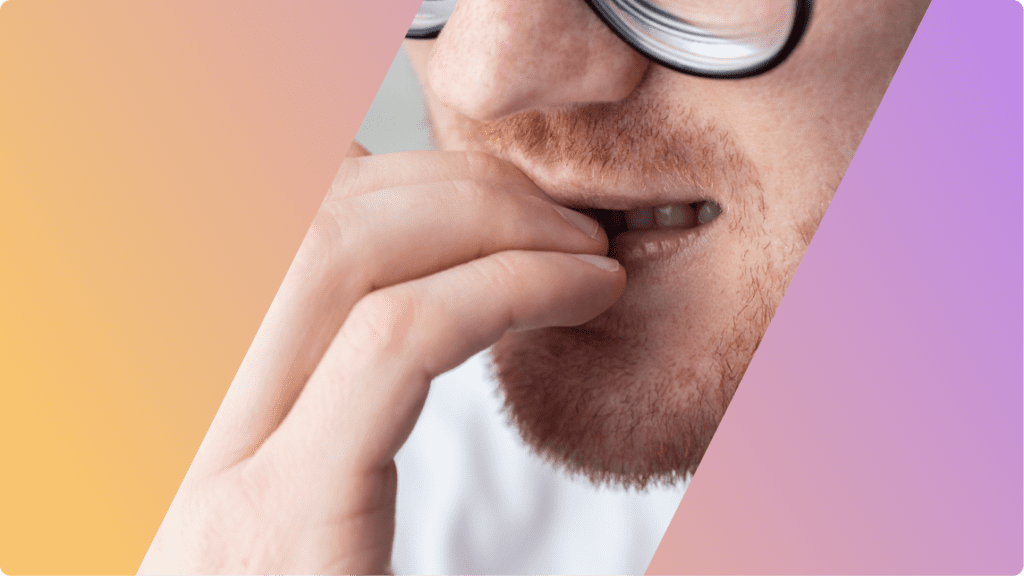Lauren Garkow, a content creator on TikTok, was 17 when she started picking the skin on her scalp repeatedly—causing open wounds and bald spots. “I pick at it even if it’s bleeding,” she said in a video. “I have a constant need to pick and I can’t do anything until I fulfill that need.”
Despite redness and scarring, she can’t stop picking. Instead, Garkow is hooked on the sense of temporary relief and gratification. “It’s an endless cycle of searching for anything on my scalp.”
Garkow has a very common condition called excoriation disorder or dermatillomania, a skin-picking disorder that falls in the category of body-focused repetitive behaviors (BFRBs), along with nail biting, hair pulling, and more.
BFRBs can be thought of as normal grooming behaviors gone awry. In other words, while many people pick the occasional scab or poke at a blemish from time to time, those with dermatillomania may be unable to stop. They pick their skin until it bleeds or scars, pick moles or scars, and pick anytime they’re anxious, stressed, and/or bored.
Although skin-picking disorder affects at least five million Americans, less than one fifth of people receive help for skin-picking due to the belief that the condition is just a “bad habit” or that it’s untreatable. Sometimes, social embarrassment prevents someone from getting treatment.
“I haven’t received treatment because it’s not something doctors really notice,” Garkow said. “It’s not something I bring up because I’m embarrassed and ashamed.”
Managing skin picking can be challenging, but make no mistake: With the right strategies and support, it’s possible to make progress. Here are six tips to help reduce or even stop picking your skin.
Want to stop picking your skin? Talk to a treatment provider who specializes in treating BFRBs.
1. Identify your triggers
“Automatic skin-picking” occurs more or less unconsciously—without even realizing you’re doing it—often during activities like watching TV or talking on the phone. “Focused skin picking” is more deliberate. Maybe you see a “blemish” or “imperfection” on your skin and consciously begin to pick, possibly to regulate your emotions.
Triggers vary across individuals but can include stress, anger, anxiety, boredom, or tiredness. Sometimes, a specific environment—such as school or work—can trigger skin-picking to reduce negative emotions or release tension. “There’s this built up tension in the body,” explains therapist and NOCD’s Chief Clinical Officer Dr. Patrick McGrath, and if this happens for you, “recognizing when tension is building up is key to being able to interfere with the experience of skin-picking.”
2. Increase awareness
“From a treatment point of view, we try to make people aware of their habits,” McGrath said. “You want to create awareness so you can then create barriers.”
One tip he gives? If you tend to pick automatically, wearing a band-aid on your finger so it feels different when you pick your skin can help you realize when you’re doing it.
Likewise, journaling is a powerful tool for enhancing self-awareness. Whether you keep a written diary or track patterns in your Notes app, tracking the thoughts, feelings or situations that promote picking goes a long way.
3. Create physical barriers
A few things can “block” you from picking—or at least make you more conscious about when you’re doing it. These include wearing gloves, keeping nails short, or—if you tend to pick on parts of your body that aren’t your face—wear long-sleeved shirts and pants to make the skin a bit harder to access.
“Some people try to do what an esthetician does, specifically using tools on their skin to try to ‘smooth’ or ‘perfect’ it—but they are not trained to do that,” McGrath said. “In fact, that may cause more harm.” If you’re prone to using not just your fingernails but pins, tweezers, and cuticle cutters on your skin, try keeping these tools completely out of sight.
4. Start therapy
Habit-reversal training (HRT) is a behavioral therapy designed to help people with BFRBs. Research shows it can help you quit or reduce how often you pick your skin.
Treatment involves increasing your awareness of when you have the urge to pick, and teaches you to reach for a behavior that directly competes with the skin-picking, like clenching your fists, clasping your hands, or putting your hands underneath your legs until the feeling subsides.
Keep in mind, it’s not recommended to engage in HRT without the guidance of a qualified professional.
Get your life back from skin picking disorder
5. Ask your provider about medication
Medications for BFRBs have shown more limited potential than behavioral therapy like HRT, but that doesn’t mean it can’t be helpful for some.
While no medications are approved by the FDA as a first-line treatment for skin picking, limited research has found that certain antidepressants (in the class of medicines known as selective serotonin reuptake inhibitors, or SSRIs), and nutraceuticals, such as n-acetyl cysteine (NAC), can help.
Talk to your clinician to see if therapy combined with medication might be helpful for you.
6. Find the right support
“Culturally, many people hear things like ‘you should be able to break this habit on your own,’” McGrath said. These types of messages only keep people suffering longer—not only with the condition itself, but with the shame they’ve associated with it.
In addition to working with a therapist who understands the condition, it’s helpful to open up to close confidants who respond with care instead of judgment. You can also tell these friends that you’re trying not to pick your skin—so they can help let you know when you’re doing it.
Bottom line: While there’s no quick fix for dermatillomania, with the right treatment and support—along with a healthy dose of self-compassion—it’s possible to manage your condition while dismantling some of the shame, too.
Treatment you can afford
Use your insurance to work with a NOCD specialist.

